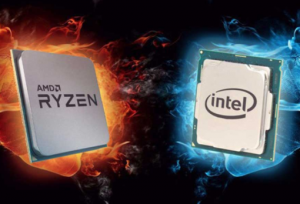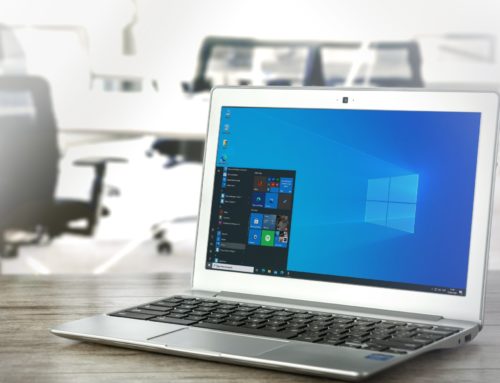AMD vs Intel: The great tug of war
With the latest processors and hardware, comes improved architecture, performance, and stability. In this article, we’ll explain the pro’s, cons and result of the continuous tug-of-war between AMD and Intel.

AMD has always been known for giving you more value for the same price as a similar Intel chip. This is partly to do with Moore’s Law and how small the transistors on the chip are. AMD have been using 7nm while Intel are still utilizing double the size, at 14nm. The smaller the size of the parts, the more cores can be fit, the more powerful the processor will be.
Both companies offer a wide range of price points, but they also offer cheaper processors in all of their latest line-ups. AMD processors are available for a less expensive price than Intel-based ones. They also offer a wider selection of processors at a higher price, with AMD processors always available as a cheaper alternative.

Both AMD and Intel offer credible performance for work and gaming, but there are many other considerations when buying a new setup, and having a look at individual models and reviews is a must. If you are considering buying the best – most powerful – CPU on the market, you might want to try the top processors in the Intel range, which still perform somewhat better than their AMD counterparts. Here you can see the difference between the nodes. An interesting thing to note is the gate width. The 14 nm transistor isn’t 14 nm in width, and the same goes for the 7nm. The naming of the node and actual size of the node have had a departure a long time ago, and the naming convention is really up to the manufacturer
AMD vs Intel: Why is AMD cheaper than Intel?
Right now, Intel is perceived as the best manufacturer of CPUs. AMD’s Ryzen might be an excellent product, but a lot of people are familiar with Intel thanks to their marketing and big obvious stickers.
Currently, the only way for AMD’s processors to succeed is to offer an interesting value proposition.
Intel has been the market leader for so long, and has been able to steadily hike up their prices. AMD is able to offer lower prices by thinking that even though the margins are lower, the number of CPUs sold should make up for the difference. From a technical standpoint, Ryzen chips can be cheaper to manufacture due to use of the ‘Infinity Fabric’ technology. This allows for AMD to make very high core-count CPUs.
AMD vs Intel: performance difference?
In the non-gaming work environment of AMD and Intel CPUs, the picture is drawn much cleaner. AMD’s chips can blast Intel chips out of the water in terms of the ultimate performance in threaded productivity and content creation applications. The Ryzen 5000 processors have expanded AMD’s current lead. The copious galore of threads, cores, and cache on its processors also equals a big win in the performance-per-dollar category.
If you’re building a computer for gaming purposes, differences can become more noticeable. With a high-end GPU like an RTX 2080 or RTX 3080, the fastest Intel CPU’s typically lead AMD’s best Ryzen parts by 5-10 percent, and in some games the gap can be as large as 15 percent.
The fastest gaming CPUs right now is Intel’s latest (8th, 9th, and 10th) generation CPUs, codenamed Coffee Lake and Ice Lake. The 8th generation parts arrived at stores in 2017 Q4, while the first 9th Gen CPUs came out a year later during October in 2018. All the 8th and 9th Gen processors run in socket LGA1151 motherboards equipped with 300-series chipsets. That’s not to be confused with LGA1151 motherboards that have 100-series or 200-series chipsets. Those sockets are meant for 6th and 7th Gen Intel processors.
Part of the reason AMD’s earlier Ryzen CPUs are slower in games is because the games don’t utilize of more than four to six cores at any given time. The extra cores on Ryzen CPUs are idle in most cases. That’s beginning to change, but the other side to the equation is latency—the time required to access and process the actual data. AMD processors tend to have more latency than their Intel counterparts. It’s an insignificant change in spec; however, the differences are subtle with Intel clocking input latency around 40us while AMD clocks in at 80-100us.
AMD vs Intel: Multi-thread vs Single-thread performance
With the advancement of software technology, developers have been finding ways to allow applications and games to utilize more than one core of the CPU. This is especially true for most modern games that require a lot of processing power to run smoothly. Games tend to use multi-threading capabilities, while most software applications prefer a single thread for stability.
Previously, Intel had shifted its focus towards having better single-threaded performance rather than multi-threaded optimization. AMD did the opposite, assuming multi-threaded performance would be more suitable. These architectural differences are only noticeable if the user is playing heavy games, rendering videos, or compiling code. The average home user won’t see the difference as he/she doesn’t use software that utilizes such a significant amount of CPU power.

The AMD Ryzen 5000 series processors have taken the uncontested lead in single-threaded performance across the full spate of our benchmarks. It’s an impressive design and equates to faster performance in all manner of workloads, particularly apps and software that rely on snappy responsiveness from the chip.
For professionals that are looking for the best performance in creation and productivity applications, the winner between Intel and AMD is a pretty one-sided affair. AMD’s lack of integrated graphics on its 8-core and above CPUs means that you’ll have to stick with Intel if you want to build a rig without dedicated graphics. Still, most professional users will want to have a dedicated graphics card regardless.
AMD vs Intel: Power usage and requirements
AMD always had a reputation for producing power-hungry processors.
Both AMD and Intel have powerful and capable designs; there’s no question about it. However, when it comes to the detailed specifications, there are many differences between them. While Intel was almost always first in technological advances in the past, nowadays, that line has become blurred by AMD’s new Ryzen series line-up. The tides have shifted and with AMD switching over to 7nm manufacturing, it allows for Ryzen CPUs to have increased density per mm. This generates less heat, and requires less power to run compared to similar Intel processors. Intel has made no further plans to manufacture smaller transistors and they’ll be sticking with the 14nm lithography for their next 11th generation chips.
The latest Ryzen 3rd generation (Zen 3) CPU’s consume less power than their Intel counterparts. A Ryzen chip would go up to about 120W at max load while an Intel chip would perform at the same load at around 200W. This is because of the transistor manufacturing difference in size. 7nm is a lot easier to power than 14nm, which requires almost double the power.
AMD vs Intel: Final verdicts
In terms of value, it’s easy to see the difference between the Ryzen and Intel CPUs. You can get an 8-core/double-threaded Ryzen 7 CPU starting at $160, and with that comes a cooler that completes the CPU. Head down to a 6-core Ryzen 5 and prices range from as low as $120. AMD also makes budget-friendly APUs. These are 4-core CPUs combined with a modest integrated graphics solution. The chip is typically twice as fast as Intel’s current integrated graphics processor. Or you can take the cake with the Ryzen 9 3900X and get a 12-core desktop CPU for $499. For each category, Intel’s equivalent CPUs are more expensive and the desired K-series chips don’t even include a cooler.
Intel CPUs are typically the favorable choice for overclocking and performance enthusiasts. While the overclocking range for the latest 8-core is limited (4.9-5.1GHz being the typical maximum without exotic cooling solutions), the 8th Gen parts hit similar overclocks but start at lower base clocks. Intel’s top CPUs are more expensive than their AMD counterparts, especially if you throw in a decent cooler, but they’re often a bit faster in games and graphically intensive applications.
AMD is able to trump Intel when it comes to multithreaded applications. Intel has no real ‘mainstream’ argument for the 3900X, never mind the 3950X. Their HEDT solution has up to 32-core solutions with Threadripper 3000 CPUs.
Right now, the competition for dominance between AMD and Intel is closer than we’ve ever seen since they released the first Athlon 64 in 2003. AMD hasn’t held the outright performance crown since 2006, not in every meaningful category at least. The Ryzen 9 3900X and 3950X are by far the fastest mainstream CPUs for non-gaming work, but Intel still squeaks by with a win in the gaming category.
Competition in the CPU category has been a lovely sight to see. Pretty soon, 64 core CPU’s will become a standard as the transistor design becomes even smaller and the architecture improves each year.






